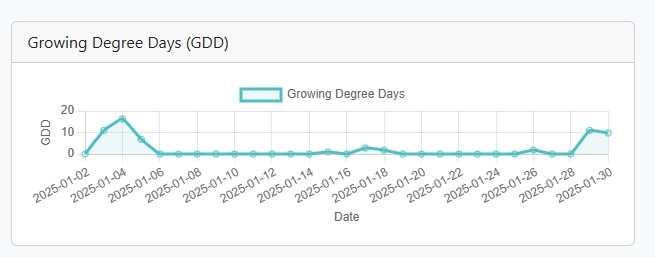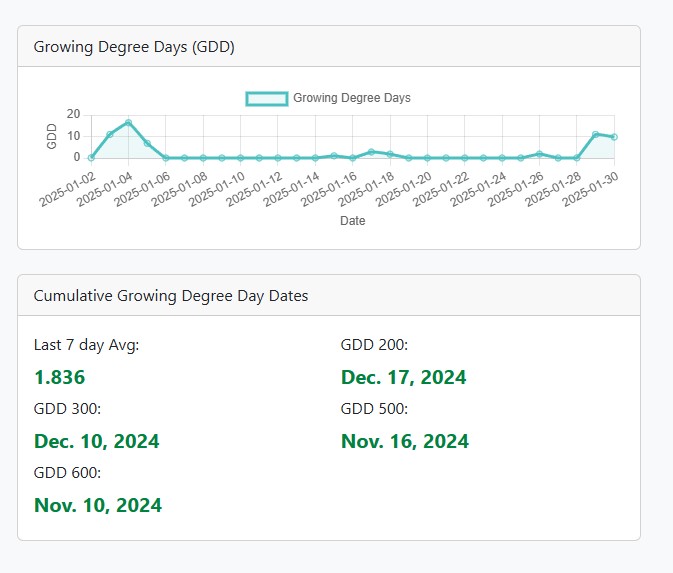Understanding Growing Degree Days (GDD)
Published on February 1, 2025

Tracking GDD in your ZIP code available to subscribed members
Growing Degree Days (GDD) are an essential tool for anyone managing Bermuda grass, whether you’re a homeowner, landscaper, or turf professional. GDD provides a scientific way to track the growth and dormancy cycles of your lawn by measuring heat accumulation over time. This information is invaluable for making informed decisions about lawn care, including the safe application of herbicides like glyphosate, the timing of fertilizer applications, and the use of plant growth regulators (PGRs) like T-nex. By understanding GDD, you can optimize your Bermuda grass management practices to ensure a healthy, vibrant lawn year-round.
What Are Growing Degree Days?
GDD is a measure of heat units that accumulate over time, calculated using daily temperature data. For Bermuda grass, the base temperature is typically 50°F, meaning growth begins when temperatures consistently exceed this threshold. The formula for calculating GDD is:
GDD = (Max Temp + Min Temp) / 2 – Base Temp (50°F).
For example, if the high temperature for the day is 85°F and the low is 65°F, the GDD for that day would be (85 + 65) / 2 – 50 = 25 GDD. These daily values are accumulated over the growing season to track the grass’s growth stages.
GDD and Bermuda Grass Dormancy
Bermuda grass is a warm-season grass that thrives in temperatures between 60°F and 95°F. When temperatures drop below 50°F, the grass enters dormancy, turning brown and ceasing active growth. GDD helps you identify when this transition occurs. By tracking GDD trends, you can predict when your lawn is likely to go dormant in the fall and when it will green up in the spring.
For example, in the fall, as temperatures cool and GDD accumulation slows, you’ll know your lawn is preparing for dormancy. Conversely, in the spring, a steady increase in GDD indicates that the grass is breaking dormancy and resuming active growth. This knowledge is critical for timing lawn care practices, such as herbicide applications and fertilization.
Using GDD to Safely Apply Herbicides
One of the most important applications of GDD is determining the right time to apply herbicides like glyphosate. Glyphosate is a non-selective herbicide that can damage Bermuda grass if applied during active growth. However, during dormancy, when the grass is not actively growing, the risk of damage is significantly reduced.
By monitoring GDD, you can identify when your lawn is fully dormant and safe for glyphosate applications. For instance, if GDD values have plateaued or declined, and your grass has turned brown, it’s a good indication that dormancy has set in. This is the ideal time to target winter weeds without harming your Bermuda grass. On the other hand, applying glyphosate during periods of active growth (when GDD values are high) can lead to severe damage, as the herbicide targets actively growing plants.
GDD and Fertilizer Applications
GDD can also guide your fertilization schedule. Bermuda grass requires nutrients during its active growth phase, which coincides with rising GDD values. Applying fertilizer too early in the spring, before the grass has broken dormancy, can lead to nutrient runoff and wasted resources. Similarly, fertilizing too late in the fall, when the grass is preparing for dormancy, can promote tender growth that is susceptible to winter damage.
By tracking GDD, you can time your fertilizer applications to align with the grass’s natural growth cycle. For example, once GDD values indicate that the grass is actively growing, you can apply a balanced fertilizer to support healthy development.
GDD and Plant Growth Regulators (PGRs)
Plant growth regulators like T-nex are another area where GDD can be incredibly useful. PGRs work by slowing vertical growth, which reduces mowing frequency and promotes a denser, healthier turf. However, for PGRs to be effective, they need to be applied during periods of active growth.
GDD helps you identify these periods. When GDD values are consistently high, it’s a sign that the grass is growing vigorously and will respond well to PGRs. Applying T-nex during these peak growth periods ensures maximum effectiveness, helping you maintain a well-manicured lawn with less effort.
Timing PGR Applications with GDD
For optimal results, PGRs like T-Nex (Recomended Products) should be applied at specific GDD intervals. Research and product guidelines often recommend reapplying PGRs every 200 to 500 GDD after the initial application. Here’s how this works:
-
200 GDD Reapplication: After the first application, the grass will typically slow its vertical growth for about 200 GDD. Once this threshold is reached, the PGR’s effects begin to wear off, and the grass resumes normal growth. Reapplying at this point ensures consistent growth suppression.
-
500 GDD Reapplication: For longer-lasting effects, some PGRs can be reapplied every 500 GDD. This interval is ideal for maintaining growth control over an extended period, especially during peak growing seasons.
By tracking GDD, you can precisely time these reapplications, ensuring your Bermuda grass remains healthy and well-maintained without over-applying chemicals.
Premium Membership Benefits: GDD Tracking Tools

For those looking to take their lawn care to the next level, premium membership options often include advanced GDD tracking tools. These tools allow you to monitor key GDD milestones, such as 200 and 500 GDD intervals, in real-time. With the running tracker, it'll be easier to check when it's time to reapply PGRs, fertilize, or adjust other lawn care practices. This level of precision ensures your Bermuda grass receives the right care at the right time, maximizing results while minimizing effort.
Conclusion
Growing Degree Days are a powerful tool for managing Bermuda grass. By tracking GDD, you can accurately predict when your lawn is dormant or actively growing, allowing you to make informed decisions about herbicide applications, fertilization, and the use of plant growth regulators like T-nex. Whether you’re targeting weeds, feeding your lawn, or optimizing growth, GDD provides the data you need to keep your Bermuda grass healthy and thriving throughout the year. By incorporating GDD into your lawn care routine—and leveraging premium tracking tools—you can achieve better results while minimizing risks and maximizing efficiency.